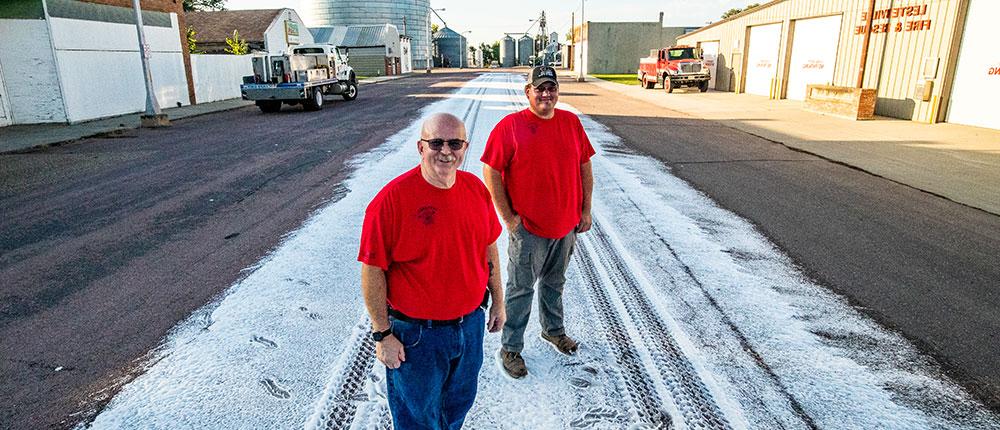Growing America’s essential cotton crop

U.S. cotton growers rely on cooperative expertise to get the most from their cotton crop.
Corn, soybeans and wheat may take center stage in American agriculture, but cotton has earned a strong supporting role. As a key fiber in everything from T-shirts to toilet paper and much more, cotton blankets our everyday lives.
To really shine, cotton demands star treatment, requiring intensive management all season long. From crop protection and in-season fertilizer applications to harvest aids, multiple inputs are needed to effectively manage a cotton crop from start to finish.
“Cotton likes to throw curveballs,” says Seth Byrd, a cotton specialist with Oklahoma State University Extension. “You can’t simply plant the crop and walk away. Insect pests can rapidly cause irreversible damage to a cotton crop without proper scouting and control measures.”
Cotton partnerships at the co-op
“Many of our relationships with cotton producers are end to end,” says Jason Kroener, general manager of the CHS location based in Okarche, Okla. “Our agronomists help growers formulate crop plans, guide them through seed decisions, make timely agronomic decisions based on plant conditions and weather, and ultimately see the crop through to the ginning process.”
Working with the cooperative team provides reassurance in decision-making and a sounding board to discuss new ideas and strategies, says Nathan Kreutziger, a second-generation cotton producer in southwestern Oklahoma. “I rely on my CHS agronomist to be another set of eyes on my fields. Having this relationship with a trusted agronomist gives me confidence in the management decisions I make for my farm.”
Kroener says adding the Red River Cotton Gin to CHS assets in March 2020 completed the journey for the cotton producers his team works with. “Acquisition of the cotton gin gave us access to a different crop market. We couldn’t fully support the end-to-end cotton cycle before the gin. Now we’re partners from seed selection through the ginning process.”
Advances in cotton production
After invention of the cotton gin in the late 1800s, the industry boomed. But it didn’t take long for pests such as the boll weevil to put a damper on cotton yields. To mitigate losses, Bt cotton was introduced to manage insect damage.
“More than 95% of cotton is now Bt-traited,” Byrd says. That added control helps reduce some crop protection application needs. Other agronomy advancements are also paying off for producers.
Four products in particular are showing great results in the field. “Bollbuilder® provides micronutrients that help retain bolls on the cotton plant,” says William Russell, agronomy technical specialist, CHS. “Levesol® Zinc is a unique chelation product that prevents micronutrients from being tied up in the soil with phosphorus. The chelating process helps make micronutrients and phosphorus more available in the soil for uptake and plant growth.”
Adjuvants Level Best® and Tapran™ are good fits for use on cotton plants, says Mark Morris, the agronomy sales manager on the CHS team based in Okarche. “We’ve seen great success using Level Best to help cotton producers control weeds. Tapran provides more consistent desiccation and defoliation for more efficient harvesting.”
While seed traits and genomic research have advanced, too, the biggest shift has come in harvesting methods.
Growers can choose between two types of machinery to harvest their crop: cotton pickers or cotton strippers. Cotton pickers remove cotton from the boll, while cotton strippers pull off the entire boll, then separate the cotton from the boll.
Once cotton is free from bolls and unwanted vegetation, it is pressed into either a rectangle or round cotton module. A rectangle cotton module weighs about 18,000 pounds, while a round module — which consists of four round bales — weighs about 20,000 pounds.
“There has been rapid movement away from conventional rectangular cotton modules to round cotton modules,” Kroener says. Creating round modules allows producers to operate more efficiently and independently, with less worry about having enough labor during harvest to get the job done.
“Investing in a round module machine has made a big impact on my farm,” says Kreutziger. “Before using the round module builder, I would have three to five machines running in my field during harvest, which required that many people to operate those machines. Now I can keep the round module builder running with just one person and I can run day and night if I need to.”
U.S. cotton producers positioned for success
The domestic cotton industry has positioned itself to consistently be among the leaders in producing the best quality cotton.

“U.S. cotton growers are on the cutting edge of new technologies,” says Byrd. “This places us in a competitive position in the global market, which in turn offers a profitable crop for producers to grow.”
As Kreutziger looks toward the future of his cotton operation, he is hopeful for consistent prices and stable markets. “There are lots of opportunities in cotton farming, but our success revolves around input costs and weather,” he says. “My goal is to continue producing cotton to keep the world clothed.”

The cotton ginning process
- Module haulers pick up cotton modules in the field and take them to the cotton gin.
- Each module receives a number for tracking purposes; cotton from multiple farms will be ginned together in the order the modules were received.
- Plastic wrapping is removed from cotton modules and the cotton is “chewed up” or fluffed.
- Cotton moisture is kept at a consistent level throughout the ginning process.
- Cotton moves through cleaners to remove burs, sticks and other field debris.
- Seeds are separated from cotton fiber or lint.
- Raw lint is cleaned again.
- Lint is pressed into 480-pound bales and wrapped in plastic for export.
- Cotton by-products are turned into cottonseed oil, livestock feed, mattress stuffing and other materials.
Check out the full Winter 2022 issue of C magazine with this article and more.




